Mario Artist (series): Difference between revisions
(Undo revision 4123129 by 98.25.44.91 (talk) vandal) Tag: Undo |
|||
| (69 intermediate revisions by 33 users not shown) | |||
| Line 1: | Line 1: | ||
{{italic title}} | {{italic title}} | ||
'''''Mario Artist''''' is a series of four Japan-exclusive games for the [[Nintendo 64DD]], serving as spiritual successors to ''[[Mario Paint]]''. Originally, eight games in total were announced, but half of them were canceled due to the failure of the 64DD. | |||
'''''Mario Artist''''' is a series of four games for the [[Nintendo 64DD]] | |||
==Games== | ==Games== | ||
=== | {| align=center width=100% class="wikitable" | ||
|- | |||
''[[Mario Artist: Paint Studio]]'' | !style="background-color: #d9d9d9;font-size:125%;text-align:left" colspan="2"|Title | ||
|- | |||
!width=15% style="background-color: #e0e0e0;"|Cover and original release | |||
!width=85% style="background-color: #e0e0e0;"|Synopsis | |||
|- | |||
!colspan="2" style="font-size:125%;text-align:left"|''[[Mario Artist: Paint Studio]]'' | |||
|- | |||
|[[File:MAPaintStudio.jpg|150x150px]]<span style="font-size:8pt"><br>{{release|Japan|December 11, 1999}} | |||
|'''''[[Mario Artist: Paint Studio]]''''' began as a direct sequel to ''[[Mario Paint]]'', and bears many similarities to it. Players could draw original creations, utilize various pre-rendered images, animate frames, create slideshows and interact with a 3D world. It was one of only two launch titles for the [[Nintendo 64DD]]. Images could be imported from an [[Wikipedia:RCA connector|RCA]] source using the [[Nintendo 64DD#AV-In Cartridge|{{conjectural|capture cartridge}}]] or a [[Game Boy Camera]]. It also came with a unique four-player drawing mode where four players could collaborate to make one drawing together. | |||
|- | |||
!colspan="2" style="font-size:125%;text-align:left"|''[[Mario Artist: Talent Studio]]'' | |||
|- | |||
|[[File:MATalentStudio.jpg|150x150px]]<span style="font-size:8pt"><br>{{release|Japan|February 23, 2000}} | |||
|'''''[[Mario Artist: Talent Studio]]''''' allows users to insert pictures from cameras and videos onto 3-dimensional models, and then animate the models. Using the Capture Cartridge, which this game was bundled with, movies could be recorded by running a video camera through the Capture Cartridge. This game boasts an in-depth personal avatar creator app; said avatars could be imported as city residents into the Nintendo 64DD title, ''{{wp|SimCity 64}}''. | |||
|- | |||
!colspan="2" style="font-size:125%;text-align:left"|''[[Mario Artist: Communication Kit]]'' | |||
|- | |||
|[[File:MACommunicationKit.jpg|150x150px]]<span style="font-size:8pt"><br>{{release|Japan|June 29, 2000}} | |||
|'''''[[Mario Artist: Communication Kit]]''''' was an accessory to the other ''Mario Artist'' games. It allowed users to connect to the RandNetDD internet service, so users could share their creations in the other ''Mario Artist'' games with others. The RandNet only ran for little over a year. | |||
|- | |||
!colspan="2" style="font-size:125%;text-align:left"|''[[Mario Artist: Polygon Studio]]'' | |||
|- | |||
|[[File:Mario Artist Polygon Studio.jpg|150x150px]]<span style="font-size:8pt"><br>{{release|Japan|August 29, 2000}} | |||
|'''''[[Mario Artist: Polygon Studio]]''''' allows users to construct and render 3-dimensional polygons, and then explore a 3D world with their creation to unlock more parts. The game includes a mode called "Sound Bomber" (サウンド ボンバ- ''Saundo Bonbā''), where the player has to win as many minigames as possible, all of them featuring the player's polygon model in some way. | |||
|} | |||
==Canceled games== | |||
[[File:Mario-artist-gnat-attack.png|thumb|Unused version of [[Gnat Attack]] from ''Paint Studio''.]] | |||
== | |||
[[File: | |||
*''Mario Artist: Game Maker'' | *''Mario Artist: Game Maker'' | ||
*''Mario Artist: Graphical Message Maker'' | *''Mario Artist: Graphical Message Maker'' | ||
| Line 28: | Line 38: | ||
*''Mario Artist: Video Jockey Maker'' | *''Mario Artist: Video Jockey Maker'' | ||
Additionally, ''Mario Artist: Paint Studio'' was originally going to feature a minigame similar to [[Gnat Attack]], but it was removed in the final product. | |||
{{br}} | |||
== | ==Legacy== | ||
Though the ''Mario Artist'' series, as well as the Nintendo 64DD as a whole, were seen as a failure, many concepts utilized within were later revisited and worked upon by [[Nintendo]]. Nintendo designer Yamashita Takayuki attributes his work on ''Mario Artist: Talent Studio'', namely its avatar creation tool, as having been foundational to his eventual work on the [[Mii]]s introduced in the [[Nintendo Wii]]. Some of these ideas were also implemented into ''{{wp|Wii Sports}}''. The Sound Bomber mode to ''Mario Artist: Polygon Studio'' is a direct precursor to the ''[[WarioWare (series)|WarioWare]]'' series, inspiring the games and series as a whole. All minigames featured within ''Mario Artist: Polygon Studio'' were implemented into [[Microgame|microgames]] in ''[[WarioWare, Inc.: Mega Microgame$!]]''. | |||
Mario can unlock an outfit in ''[[Super Mario Odyssey]]'', based on his appearances from the ''Mario Artist'' series and ''Mario Paint''. In ''[[Mario Kart Tour]]'', [[Luigi|Luigi (Painter)]] is partially based on Mario's appearance in this series. | |||
== | ==Names in other languages== | ||
{{foreign names | |||
|Jap=マリオアーティスト | |||
|JapR=Mario Ātisuto | |||
|JapM=Mario Artist | |||
}} | |||
= | |||
{{Super Mario games}} | |||
{{unreleased media}} | |||
[[Category:Mario Artist series|*]] | |||
[[Category:Games]] | [[Category:Games]] | ||
[[Category:Game series]] | [[Category:Game series]] | ||
[[Category:Canceled | [[Category:Canceled games]] | ||
[[Category:1999 games]] | [[Category:1999 games]] | ||
[[Category:2000 games]] | [[Category:2000 games]] | ||
[[Category:Japan | [[Category:Japan-only games]] | ||
[[it:Mario Artist (serie)]] | |||
Revision as of 20:32, January 24, 2024
Mario Artist is a series of four Japan-exclusive games for the Nintendo 64DD, serving as spiritual successors to Mario Paint. Originally, eight games in total were announced, but half of them were canceled due to the failure of the 64DD.
Games
| Title | |
|---|---|
| Cover and original release | Synopsis |
| Mario Artist: Paint Studio | |
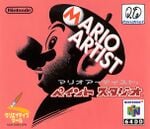 |
Mario Artist: Paint Studio began as a direct sequel to Mario Paint, and bears many similarities to it. Players could draw original creations, utilize various pre-rendered images, animate frames, create slideshows and interact with a 3D world. It was one of only two launch titles for the Nintendo 64DD. Images could be imported from an RCA source using the capture cartridge or a Game Boy Camera. It also came with a unique four-player drawing mode where four players could collaborate to make one drawing together. |
| Mario Artist: Talent Studio | |
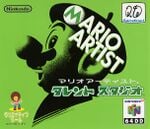 |
Mario Artist: Talent Studio allows users to insert pictures from cameras and videos onto 3-dimensional models, and then animate the models. Using the Capture Cartridge, which this game was bundled with, movies could be recorded by running a video camera through the Capture Cartridge. This game boasts an in-depth personal avatar creator app; said avatars could be imported as city residents into the Nintendo 64DD title, SimCity 64. |
| Mario Artist: Communication Kit | |
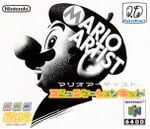 |
Mario Artist: Communication Kit was an accessory to the other Mario Artist games. It allowed users to connect to the RandNetDD internet service, so users could share their creations in the other Mario Artist games with others. The RandNet only ran for little over a year. |
| Mario Artist: Polygon Studio | |
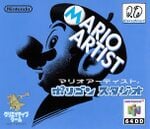 |
Mario Artist: Polygon Studio allows users to construct and render 3-dimensional polygons, and then explore a 3D world with their creation to unlock more parts. The game includes a mode called "Sound Bomber" (サウンド ボンバ- Saundo Bonbā), where the player has to win as many minigames as possible, all of them featuring the player's polygon model in some way. |
Canceled games
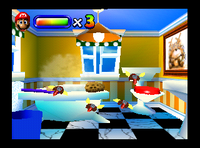
- Mario Artist: Game Maker
- Mario Artist: Graphical Message Maker
- Mario Artist: Sound Maker
- Mario Artist: Video Jockey Maker
Additionally, Mario Artist: Paint Studio was originally going to feature a minigame similar to Gnat Attack, but it was removed in the final product.
Legacy
Though the Mario Artist series, as well as the Nintendo 64DD as a whole, were seen as a failure, many concepts utilized within were later revisited and worked upon by Nintendo. Nintendo designer Yamashita Takayuki attributes his work on Mario Artist: Talent Studio, namely its avatar creation tool, as having been foundational to his eventual work on the Miis introduced in the Nintendo Wii. Some of these ideas were also implemented into Wii Sports. The Sound Bomber mode to Mario Artist: Polygon Studio is a direct precursor to the WarioWare series, inspiring the games and series as a whole. All minigames featured within Mario Artist: Polygon Studio were implemented into microgames in WarioWare, Inc.: Mega Microgame$!.
Mario can unlock an outfit in Super Mario Odyssey, based on his appearances from the Mario Artist series and Mario Paint. In Mario Kart Tour, Luigi (Painter) is partially based on Mario's appearance in this series.
Names in other languages
| Language | Name | Meaning |
|---|---|---|
| Japanese | マリオアーティスト Mario Ātisuto |
Mario Artist |